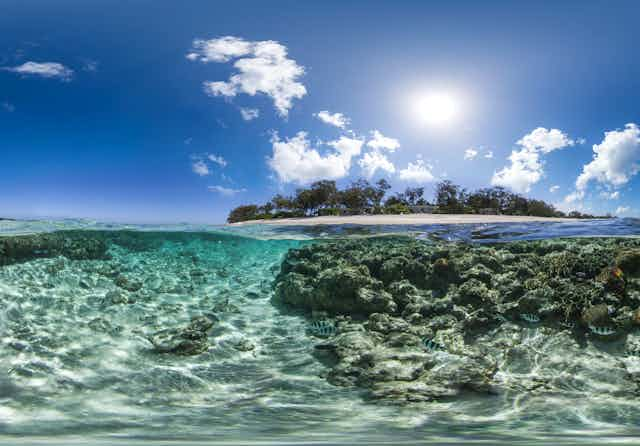Few of us remember that the declaration of the Great Barrier Reef Marine Park and its subsequent World Heritage status was born out a 12-year popular struggle to prevent the most wondrous coral reef in the world from being destroyed by uncontrolled mining.
A cane farmer’s attempt in 1971 to mine a supposedly “dead” coral clump called Ellison Reef for cheap limestone fertilizer triggered a national resistance led by the unlikely trio of a poet, an artist and a forester — Judith Wright, John Busst and Len Webb. With the help of some student divers, these three leaders of the newly formed Queensland Wildlife Protection Society were able to demonstrate that Ellison was, like most reefs, a mosaic of dead and living corals and a hub of marine bio-diversity.
They also persuaded the Innisfail Mining Warden that mining silt could not be confined to specific local areas. Instead, it would be carried by waves and currents to smother the life out of living corals situated at far off and unpredictable distances from the dredging.
The larger concern of the trio was that Ellison would serve as a precedent for the unrestrained mining ambitions of the Queensland National Party Government.
The conservationists were wrong only in thinking that Premier Joh Bjelke-Petersen worried about precedents. He instructed his mining minister to zone 80% of the 3,200 kilometre Barrier Reef for oil and gas mining. Forced to affect an objective assessment of potential environmental impact, the premier gave the task to an American geologist with extensive mining experience. He managed, in the company of government officials, to survey an area of reef the size of Japan in less than a month.
Predictably, he reported that oil-mining prospects looked good and that dead reefs could be used for cement manufacture. Judith Wright compared this last suggestion to bashing down the Taj Mahal for road gravel.
Revelations that the premier and his ministers had also invested heavily in the oil companies whose licenses they were supposed to be assessing didn’t exactly enhance the government’s credibility.
In the end it was a combination of intensive popular campaigning, news of environmentally catastrophic marine oil spills overseas, threats of trade union black bans, and bipartisan legislative action by the Federal Liberal and Labour governments that in June 1975 produced the Great Barrier Reef Marine Park.
This enacted a spectacular marine reserve for nature lovers which at the same time permitted controlled economic and recreational use. Not everyone liked the multi-use compromise, but it enabled the Barrier Reef to gain World Heritage listing in 1981 as “the most impressive marine area in the world”. And it helped the reef’s administration to acquire a reputation for responsible management.
Still, Judith Wright ended the 1996 edition of her book Coral Battleground with a chapter entitled “Finale Without Ending”, warning that popular memories were short and fresh onslaughts on the reef’s mineral resources likely to resume at any time.
And so they have. This week, the Federal Environment Minister Greg Hunt approved a swathe of new shipping and gas projects. They entail the dredging of 3 million cubic metres of spoil, which will be dumped to swirl through the reef’s waters from the aptly named Abbot Point north of Bowen*.
This dredging will enable the development of four coal export terminals, the building of a new coal seam gas refinery and a pipeline, and extended facilities to increase ship traffic through the coral-laden inner channel of the Great Barrier Reef. The minister claims this infusion of coral-choking sediment will be offset by improvements in water quality elsewhere, particularly through restrictions on agricultural sediment from farmers.
With the Alice in Wonderland logic that prevails these days, he insists, “We are actually making things better”. Those who care know that he has finally tipped the delicate balance between the economic use and the environmental protection of the reef.
Perhaps Minister Hunt has simply been influenced by brutal realism. After all, he says that the area was already industrialised, so why not more?
The Australian Institute of Marine Science tells us that 50% of the reef’s coral cover is already severely degraded, that mass coral bleaching is becoming an annual event, and that calcium-based corals and other marine species are starting to show signs of dissolution from the acidifying waters.
Should we then just give up on the greatest and most beautiful marine environment that this planet has known?
Mr Hunt’s decisions, which 40 years ago would have provoked national and international outrage, are now barely news — no more than a few column inches hidden on the inner pages of our daily newspapers.
Perhaps the self-proclaimed “Bastard of Bingil Bay”, John Busst, was right when he predicted that the Great Barrier Reef would one day become “a quarry surrounded by an oil slick”. Will Mr Hunt care when the United Nations decides to put the Great Barrier Reef on the World Heritage in danger list?
*This sentence previously stated Abbot Point is near Gladstone, but was meant to say near Bowen. It was corrected on December 19.

